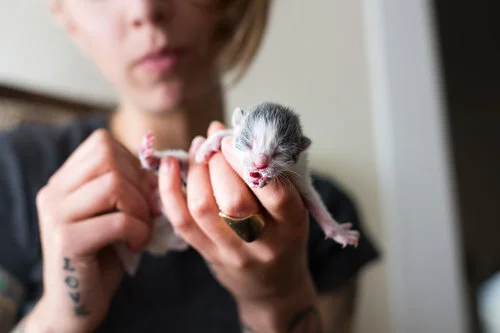Bottle Feeding
When a kitten is without a mother, it's up to us to lend a hand. Bottle feeding is an essential skill for any kitten rescuer, and Kitten Lady makes it easy to learn with this step-by-step tutorial. Anyone can learn to bottle feed, but there are some tips you'll want to have in order to do so safely. Let's get started!
1. Get a Bottle and Nipple
You can purchase a bottle at any pet supply store or feed store, or online. Be aware that the nipple that comes on the bottle is not cut; you will need to cut a hole in it yourself. The hole should be big enough that if you hold it upside down, formula can slowly drop out of it -- but not so big that it flows out freely. Pictured here are Kitten Lady's preferred nipples for kittens, available by PetAg, Pet Nurser, and Miracle Nipple.
2. Assess the Kitten
Before you feed a kitten, always make sure you've assessed her to make sure it is safe to feed. If a kitten is overheated or too cold, it is not safe to feed until you have gently stabilized their temperature. If a kitten is not able to swallow, it is not safe to feed. If a kitten has a cleft palate, it may be riskier to feed. Be sure that you've assessed the kitten's temperature and body condition before feeding.
Ensure that the kitten is able to swallow by placing a drop of formula on their tongue and feeling the throat with one finger. If the kitten appears stable and is swallowing, proceed.
3. Prepare Your Bottle
You're going to need to purchase kitten formula -- you cannot feed kittens the milk that is in your fridge. Never feed a kitten cow's milk or other dairy products, dairy alternatives, or human baby formula, as this can be dangerous or even fatal to the kitten. Instead, purchase a kitten formula from a pet supply store, feed store, or online. Once opened, keep the formula refrigerated. Prepare the formula according to the manufacturer's instructions, making sure that it is fresh, clump free, and comfortably warm.
4. Feed the Kitten
Lay the kitten in a natural, belly-down position -- never, ever on her back. Hold the kitten's head stable with your non-dominant hand. Gently slide the nipple into the kitten's mouth and invert the bottle to start the flow of formula. The kitten should roll her tongue into a U-shape and begin to swallow. Follow the feeding chart for a guideline of amount and frequency.
Be very careful not to squeeze formula into the kitten's mouth as this can cause aspiration. If you are feeding a very young kitten and having a difficult time controlling the flow, consider syringe feeding.
If the kitten latches, that's great, but it's okay if it takes a while for her to get the hang of things! Bottle feeding is an art form that improves with time, so be patient and don't give up. If the kitten is having difficulty, try these tips:
Follow this guideline to determine the proper amount and frequency of feeding. Remember that every kitten is different, and this is a guideline--not a rule book!
Be sure you're holding the head and body stable to guide her. Kittens don't necessarily understand what you're trying to do, so it's up to you to hold them steady and show them.
Take a look at your bottle and nipple, and make sure there are no issues such as a nipple that is cut too big or too small, or clumps in the formula that may be causing a blockage.
Wrap the kitten in a small baby blanket if need be to help her feel focused and swaddled; just make sure she is still in a proper belly-down position.
Rubbing the face with a cloth or toothbrush can simulate a mother's tongue and help them feel prepared to eat.
5. Complete the Routine
After feeding, always ensure that you're cleaning the face by wiping away any formula with a warm, wet cloth or baby wipe. Formula left behind can cause the kitten to get a crusty face or moist dermatitis that causes the fur to fall out, so keep her clean.
Once the kitten is cleaned up, make sure she has been stimulated to pee and poop, and is placed back in her warm, safe spot.
In this video, I share helpful tips for feeding bottle baby kittens who are having a hard time latching.
In this video, I share two methods for bottle feeding: the standard hold and the overhand hold.








